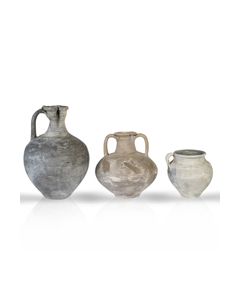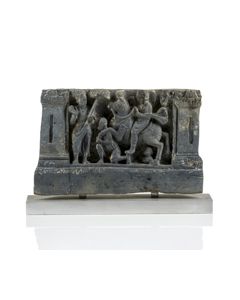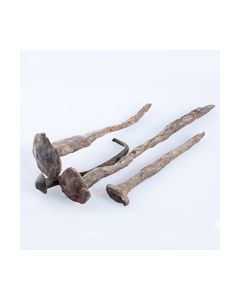Building materials - Classical antiquity - Fotogalerie - Sold antiquities
Archive of sold antiquities
All artefacts sold in our gallery are fully documented in our online archive and database. Being a specialist ancient art dealer, preserving also the more recent history of each and every piece sold in our shop is at our heart. That is particularly useful for artefacts that changed owners in the meantime. Information that may have been lost in the process can be easily restored from our archives. Please do not hesitate to contact us if you need further information about ancient items that have been sold in our gallery. We can help you with reconstructing the history of ownership for those items. All information about our customers will be kept confidential, of course.-
 Greek bronze nail
Greek bronze nailSmall nail from Attica, made of solid bronze with a convex head. Professor Manegold Collection.
Price: on request Three Roman legionary tiles from the Rhineland
Three Roman legionary tiles from the Rhineland2x LEG VI (Victrix), 70 - 104 AD, and 1x LEG XVI (Gallica), 43 - 70 AD. Found 1966 till 1981 near the Roman city of Novaesium, today's Neuss in Germany. Novaesium was an early Roman foundation and with this is one of the oldest cities in Germany.
Price: on request Two Roman jugs from the Rhineland
Two Roman jugs from the RhinelandFound 1966 till 1981 near the Roman city of Novaesium, today's Neuss in Germany. Novaesium was an early Roman foundation and with this is one of the oldest cities in Germany.
Price: on request Three small Roman Terra Sigillata bowls with potters' marks from the Rhineland
Three small Roman Terra Sigillata bowls with potters' marks from the RhinelandFound near the Roman city of Novaesium, today's Neuss in Germany, an early Roman foundation and with this one of the oldest cities in Germany.
Price: on request Roman legionary tile from the Rhineland
Roman legionary tile from the RhinelandLEG XVI (Gallica), 43 - 70 AD. Found 1966 till 1981 near the Roman city of Novaesium, today's Neuss in Germany. Novaesium was an early Roman foundation and with this is one of the oldest cities in Germany.
Price: on request Three Roman pottery vessels from the Rhineland
Three Roman pottery vessels from the RhinelandFound 1966 till 1981 near the Roman city of Novaesium, today's Neuss in Germany. Novaesium was an early Roman foundation and with this is one of the oldest cities in Germany.
Price: on request Three Roman pottery vessels from the Rhineland
Three Roman pottery vessels from the RhinelandFound 1966 till 1981 near the Roman city of Novaesium, today's Neuss in Germany. Novaesium was an early Roman foundation and with this is one of the oldest cities in Germany.
Price: on request Small Roman Terra Sigillata bowl with potters' mark from the Rhineland
Small Roman Terra Sigillata bowl with potters' mark from the RhinelandFound near the Roman city of Novaesium, today's Neuss in Germany, an early Roman foundation and with this one of the oldest cities in Germany.
Price: on request Two Roman tile fragments from the Rhineland
Two Roman tile fragments from the RhinelandWith grid pattern. Found 1966 till 1981 near the Roman city of Novaesium, today's Neuss in Germany. Novaesium was an early Roman foundation and with this is one of the oldest cities in Germany.
Price: on request Two Roman Terra Sigillata bowls with potters' marks from the Rhineland
Two Roman Terra Sigillata bowls with potters' marks from the RhinelandFound near the Roman city of Novaesium, today's Neuss in Germany. Novaesium was an early Roman foundation and with this is one of the oldest cities in Germany.
Price: on request Roman Terra Sigillata plate from the workshop of Censor
Roman Terra Sigillata plate from the workshop of CensorFound 1976 in Neuss north of the Educational College. The Roman city of Novaesium, today's Neuss in Germany, was an early Roman foundation and with this one of the oldest cities in Germany.
Price: on request Roman Terra Sigillata plate from the Rhineland
Roman Terra Sigillata plate from the RhinelandFound 1976 in Neuss north of the Educational College. The Roman city of Novaesium, today's Neuss in Germany, was an early Roman foundation and with this one of the oldest cities in Germany.
Price: on request Two Roman bowls found in the Rhineland
Two Roman bowls found in the RhinelandOne of the bowls with exactly known finding spot and years. Both found near the Roman city of Novaesium, today's Neuss in Germany. Novaesium was an early Roman foundation and with this is one of the oldest cities in Germany.
Price: on request Two Roman roof tile fragments from the Rhineland
Two Roman roof tile fragments from the RhinelandOne of the tiles with two paw prints, the other with dots. Found 1966 till 1981 near the Roman city of Novaesium, today's Neuss in Germany. Novaesium was an early Roman foundation and with this is one of the oldest cities in Germany.
Price: on request Roman legionary roof tile from the Rhineland
Roman legionary roof tile from the RhinelandFound 1966 till 1981 near the Roman city of Novaesium, today's Neuss in Germany. Novaesium was an early Roman foundation and with this is one of the oldest cities in Germany.
Price: on request Large Roman roof tile from the Rhineland
Large Roman roof tile from the RhinelandGreat condition, very rare for a Roman tile of this size. Found near the Roman city of Novaesium, today's Neuss in Germany, an early Roman foundation and with this one of the oldest cities in Germany.
Price: on request Roman facade decoration shaped as theatre mask
Roman facade decoration shaped as theatre maskImpressive and striking marble mask. It once adorned the upper facade of a villa or a public building during Roman Imperial times.
Price: on request Stone relief from Gandhara
Stone relief from GandharaWunderful example of the curious symbiosis of greek art and buddhist tradition in the second century. The relief shows a key moment in Buddhas life, when he abandons his life as prince Siddhartha to seek enlightenment.
Price: on request Large Roman funerary stela with high relief
Large Roman funerary stela with high reliefThe elaborate high relief shows the deceased resting on a kline, pointing to a tabula ansata which originally carried a painted inscription. Roman Empire, 2nd century AD. Ex Galerie Cahn, Basel.
Price: on request Large Roman legionary roof tile produced by Legio VI Victrix 70 - 104 A.D.
Large Roman legionary roof tile produced by Legio VI Victrix 70 - 104 A.D.Perfectly preserved, extremely rare for an object of this size. Found near the Roman city of Novaesium, today's Neuss in Germany, an early Roman foundation and with this one of the oldest cities in Germany.
Price: on request Large Roman mosaic of a capricorn hunt
Large Roman mosaic of a capricorn huntVery large, perfectly preserved polychrome mosaic from a Jerusalem collection.
Price: on request Egyptian tomb relief from Memphis
Egyptian tomb relief from MemphisThe flat relief shows an offering scene and above a hieroglyphic text describing the deceased Ptah-nefer, the priest and the offerings. A translation has been made by the renowned Egyptologist professor Kurth. The work of art dates to the 26th dynasty. It is adopting the style of the Old Kingdom.
Price: on request Gruppe aus 4 römischen Kleinbronzen
Gruppe aus 4 römischen KleinbronzenDarunter Teile einer Gürtelschnalle, Nagel und Zubehör. Museale Erhaltung, aus alter deutscher Sammlung.
Price: on request Gruppe römischer Nägel und Pins
Gruppe römischer Nägel und PinsZum Teil aus Bronze, sehr gute Erhaltung. Aus alter deutscher Sammlung.
Price: on request Gruppe aus vier großen römischen Nägeln
Gruppe aus vier großen römischen NägelnMit gut erhaltenen Köpfen, massiv, Bronzenagel mit schöner Patina. Aus alter deutscher Sammlung.
Price: on request
 Gruppe römischer Nägel
Gruppe römischer NägelDiverse Kopfformen, zum Teil sehr gut erhalten. Aus alter deutscher Sammlung.
Price: on request Gruppe aus vier römischen Nägeln
Gruppe aus vier römischen NägelnZum Teil mit perfekt erhaltenen Köpfen, schöne Patina. Aus alter deutscher Sammlung.
Price: on request Fragment einer Platte mit Legionsstempel LEGXV
Fragment einer Platte mit Legionsstempel LEGXVStempel der römischen XV. Legion, Mainz. Tiefer Stempel in musealer Erhaltung.
Price: on request Platte mit römischem Legionsstempel LEG XIIII GANI
Platte mit römischem Legionsstempel LEG XIIII GANIStempel der Legio XIIII G(emina) Ant(oniniana). Im Laufe ihrer Geschichte war die Legion an diversen Standorten stationiert. Ziegel ca. 198 - 290 n. Chr.
Price: on request Platte mit römischem Legionsstempel LEG V BIAE
Platte mit römischem Legionsstempel LEG V BIAEHistorisch bedeutend. Die Leg V Alaudae wurde Ende der 50er Jahre v. Chr. von Caesar aufgestellt. Stempel in Form einer tabula ansata.
Price: on request Mühlespielbrett aus einer Hypokaustanlage mit Stempel
Mühlespielbrett aus einer Hypokaustanlage mit StempelDas Stück stellt ein Unikat dar. Die Stempellesung ist unbekannt, ebenso wie Vergleichsstücke in der Forschungsliteratur.
Price: on request Fragment eines römischen Hypokaustensteins mit Legionsstempel
Fragment eines römischen Hypokaustensteins mit LegionsstempelUrsprünglich Teil einer Warmluftheizung, Stempel vermutlich der LEG XIII oder LEG XIIII (gemina). Fundort wahrscheinlich CUT (Colonia Ulpia Trajana).
Price: on request Sehr große römische Platte mit Stempel und Pfotenabdruck
Sehr große römische Platte mit Stempel und PfotenabdruckCAS P ADIV. Damit gehört der Ziegel zur Gruppe ADIVTE/ADIVTICE, von einer zivilen Großziegelei gefertigt.
Price: on request 2 Nägel, Römerzeit bis Mittelalter
2 Nägel, Römerzeit bis MittelalterZwei massive Nägel mit rechteckigem Querschnitt, verjüngen sich zur Spitze hin. Köpfe eindeutig herausgearbeitet. Länge: 169/171 mm.
Price: on request Fragment eines römischen Ziegelsteins mit Stempel LVC ADIVTE
Fragment eines römischen Ziegelsteins mit Stempel LVC ADIVTEEntstammt der ADIVTE bzw. ADIVTICE-Gruppe. Solche Stempel wurden vor allem im Fundkontext der Trierer Palastaula gefunden.
Price: on request

